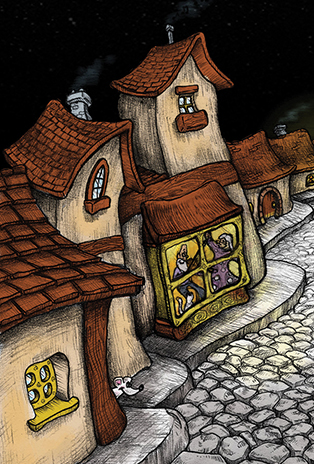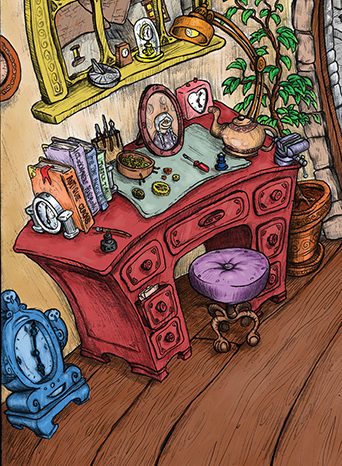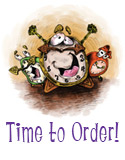The questions below are designed to help children recognize how some of the story is told through pictures (not through words) and to guide them to think critically about what is happening in the story. The questions are listed in order of the appearance of the corresponding pictures in the story.
- In the illustration with Phineas talking to Red, the cat and mouse are looking at each other from different sides of the window. What do you think they are thinking? If they could talk to each other, what would they be saying?
- From the illustration of Phineas leaving the clock shop, what can you tell about him based on the way he looks? What can you tell about him from the things (the books, the objects on his desk, the clocks, the furnishings, etc.) in his clock shop?
- Why is there a sundial (on the window sill) in the clock shop?
- Count all the teapots or kettles in the story? Why do you think there are so many?
- In the picture with the clocks squabbling, what is the mouse on top of the shelf holding in his hand? What is he doing with it? Notice throughout the story the different ways the mouse uses this object? At the end of the story on the last page, the mouse gives it back to Phineas. What do you think that shows?
- What are the three objects on the top shelf, above the window in the clock shop in the illustration where the mouse is leading the clocks out of the clock shop? You might need an adult to help you figure them out. How do these objects relate to the story?
- How is Digital World different from Westminster Clocks?
- On the billboard on the side of Digital World, why do the clocks add an e to the word Teas?
- In the illustration where a crowd of clocks is heading down the street (same as the book cover), who do you see in the picture window of the house below the big moon? To find out more about who’s there and what’s happening, go to Extras, then below Nursery Rhymes, click on Dance to Your Daddy.
- In the first illustration at Piccadilly Circus, what does it say on the lady’s shopping bag? Why is this funny?
- One of the billboards at Piccadilly Circus pictured in the story states, “Think Baroque.” In fact, some of the background music during the Piccadilly Circus section of the book is baroque style with lots of fancy trills. In the actual Piccadilly Circus in London, there’s a bilboard for a cola company. Can you guess what the actual slogan is? Hint: It rhymes with Think Baroque.
- What are some of the circus-like stunts the clocks are performing at Piccadilly Circus?

- What kind of buses are in Piccadilly Circus?
- In the Piccadilly Circus spread with the clock on the high wire. Notice that below the clock on the high wire there are four clocks going across the crosswalk. This is a spoof on a famous record album cover of a very famous British rock band. Ask a grown-up who they are and maybe they can help you look up a photo of the actual album cover online.
- In the illustration where the cat is about to enter the clock shop, who do you think is with him?
- Based on the last spread in the clock shop, what can we tell about Phineas’s relationship with the clocks, cuckoo and mice?
- Going back to question #5, what does it show when the mouse gives the minute hand back to Phineas?
- On the copyright page (the last page of the book), what book is the mouse reading? Where did he get the book, and why is he excited? Ask an adult what The Time Machine is about. Perhaps someday you will read it, too.



